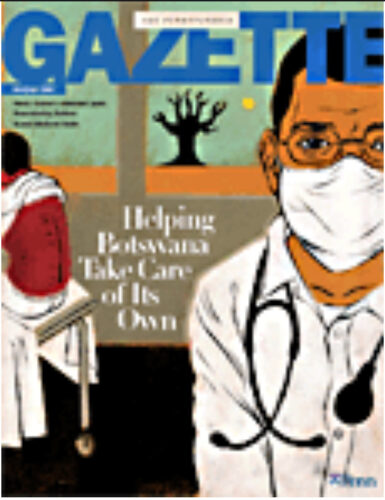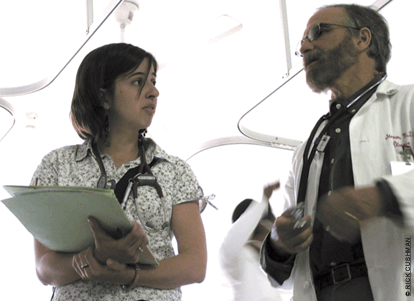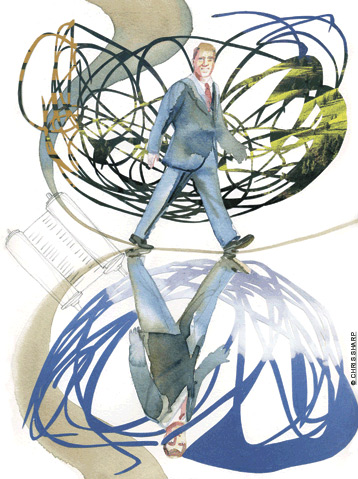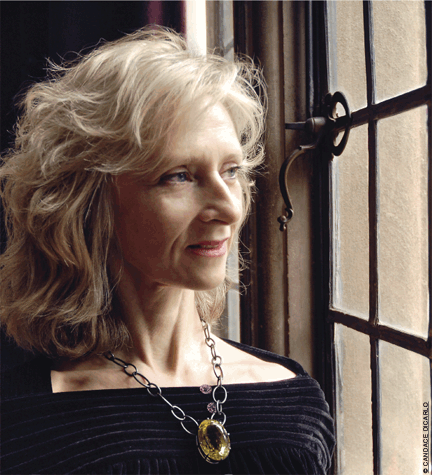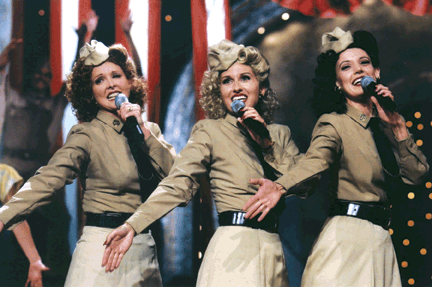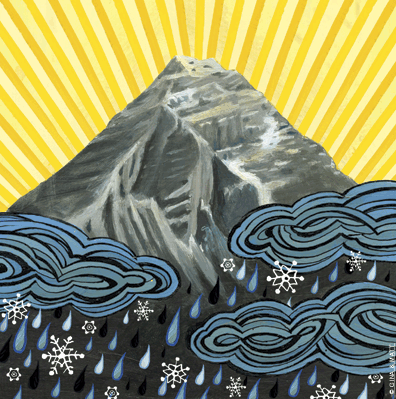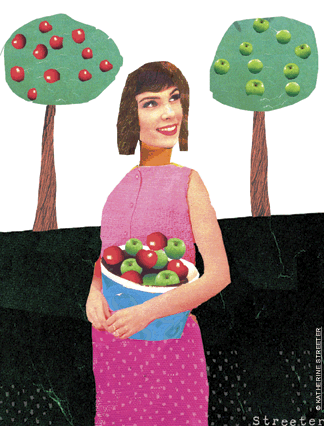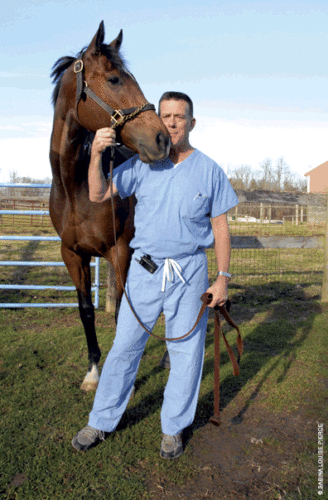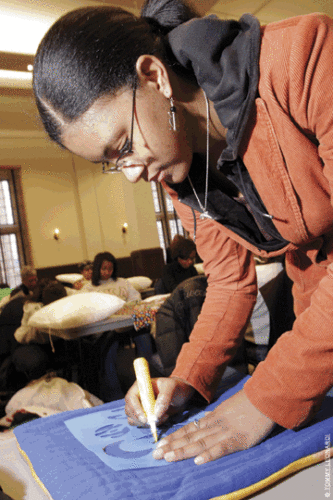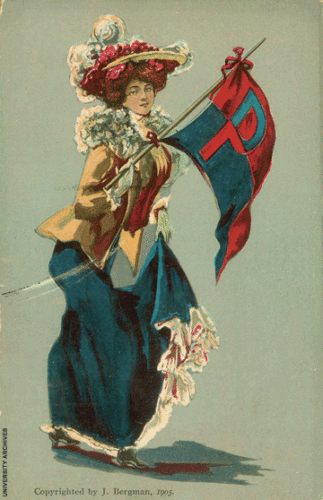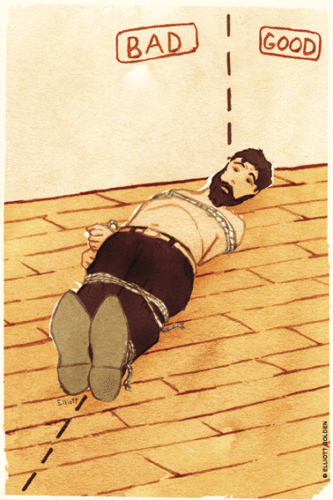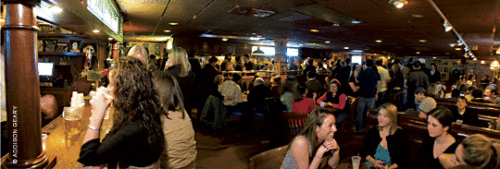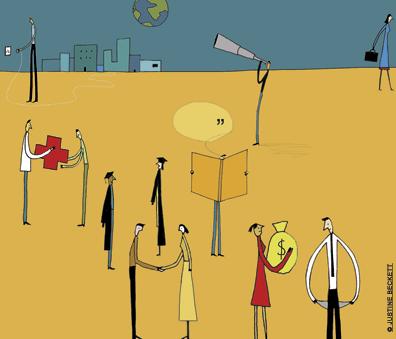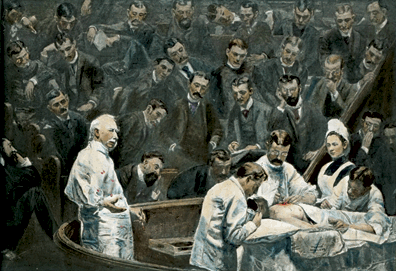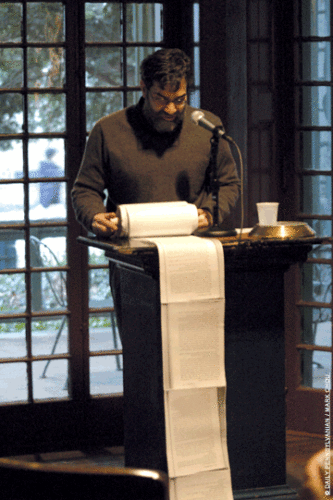Parts and Players
From the Editor: Mar|Apr 2007
Prognosis Botswana
Penn doctors, nurses, and scholars are collaborating with their counterparts in Botswana to try to change the course of HIV/AIDS (and health care itself) in one of the countries hit hardest by the disease.
Arnold Eisen’s Moment
With his appointment as chancellor of New York’s Jewish Theological Seminary, the noted religious-studies scholar—and one time Gazette student columnist and assistant to former Penn President Martin Meyerson—is only the second non-rabbi to serve as the symbolic head of American Judaism’s Conservative movement.
The Wife, the Lady, and the Book of Dames
When an English professor set out to create an animated opera based on “The Wife of Bath’s Tale,” she decided to bring in some very un-Chaucerian characters. That’s when the real fun began.
Letters
Mar|Apr 2007
Fencing Lessons
“In the moment, it always feels like dying to lose.”
Oldies School
From Penny Loafer to Swing Doll.
In Praise of Yak Dung
Practicing the “art of happiness” on a trek in the Himalayas. By Jerome D. Levin | As alluring as Everest was and is, we almost didn’t go—and, I have to admit, there were times along the way when I almost wished we hadn’t. When we landed, Nepal was on the verge of civil war and Katmandu the scene of daily clashes between police and protestors. Emptied by a strict curfew, the city’s streets were deserted and its stores shuttered. We stayed as close as possible to the airport and felt, if not endangered, depressed by the gloom of the city and its downcast inhabitants. We flew out of Katmandu without having explored it on an 18-seater the next morning. The plane cut between mountains that seemed as if you could touch them and plunged, stomach flippingly, down air pockets before landing in Lukla (which means sheep pasture) on a short strip ending in something like a runaway truck ramp. We disembarked, loaded our dzos—cow-yak hybrids used as pack animals—and started walking. Things didn’t exactly look up after that, either, at least not at first. After walking through one solid day of rain, which started about an hour after we left Lukla, followed by 40 hours of driving snow as we twisted up and down precipitous trails overlooking thousand-foot gorges, criss-crossed by narrow, swaying suspension bridges, set vibrating by yak trains, we found ourselves sitting around a cold stove, shivering in a dank lodge at over 14,000 feet in Dingbouche. We were far above the tree line, so a wood fire was out of the question. This tiny Himalayan village, now somewhat enlarged by tea houses and lodges catering to Everest trekkers, seemed the incarnation of the dismal. Dingbouche was icy, muddy, populated more by crows and dzos than by people, and getting colder by the second. The thought of spending the night that cold was terrifying us when—almost miraculously, it seemed—our luck changed. A maiden entered the dining room of our lodge with an armful of yak dung and a jar of kerosene to start it burning. Before long the stove blazed and we relaxed. Yak dung not only burns hot, at lower altitudes it saves the forest and at the higher ones it makes trekking tolerable. So ecologically sound, available, inexpensive, and vital, I offer yaks and their hybrid relatives who carried our gear, and provided cheese and fuel, my unstinting praise.... Read More
Slash Talk
Forget everything you’ve heard about work/life boundaries.
Barbaro’s Race Ends
Barbaro’s last days
Nobel-Winner MacDiarmid Dies
Nobel-prize chemist Alan MacDiarmid dies at 79
Martin Luther King Day 2007
Campus honors MLK’s legacy
Exit Alig
Alig resigns as alumni-relations AVP
Research Briefs
Attacking HIV with a (Modified) V; Found in Translation: Cholesterol-Cutting Drug; Bending DNA No Problem at Nano-Scale
Bringing Penn’s Treasures Back Home
Display highlights Penn treasures—and collector who found them.
Economics Professor on Trial
Economics professor charged with murder
The Logic of Torture
Heard on campus: Peter Singer on torture
Smokeless Smoke’s?
Smokeless Joe’s
Unlearning to Talk: Q&A with Charles Yang
How children learn language; or, why wuckoo?
Civic Scholars: A “Galvanizing” Program
New four-year program combines service and scholarship
Where’s That Other Eakins Clinic Again?
Whatever happened to Penn’s Eakins masterpiece?
On the Road Again
Kelly Writers House celebrates Kerouac classic
But Where Do They Go to Sleep?
No kitchen-sink studies? College Houses offer everything but
A Game to Remember
Foul shots down Owls in Dunphy’s return

